Have you ever tried the Aukey solar charger? Want to know the Anker vs Aukey result? Here are several Solar Chargers / USB solar panel chargers from famous manufacturers, just like Anker Solar Charger, EasyAcc Solar Charger, Aukey Solar Charger and so on. It’s very interesting to test all solar chargers I had with my smartphone and tablet.
But how well does it really work? Let’s find out in this test about these 9 USB solar chargers!
The test overview:
For this test, I have selected 9 Solar Chargers with 8W – 28W output.
- Anker 8W portable foldable solar charger
- Anker 14W dual port foldable outdoor solar charger
- Anker 21W Power Port 2-Port USB Solar Charger
- AUKEY 14W PB-P3 solar charger
- AUKEY 20W PB-P2 Solar Charger
- AUKEY 21W PB-P4 solar charger
- EasyAcc 15W portable solar charger
- EasyAcc 28W portable solar charger
- EC Technology 18W 2 Ports Solar Charger
The Test Candidates
Basically, all solar chargers are equal in this comparison. Accordingly, it makes sense to show you the picture of the individual solar panel chargers.

Brief Overview
All solar chargers have a “case” of PVC fabric in which the individual solar cells are embedded. This “housing” consists of several elements which can be folded.
Depending on the model, the solar chargers have three to five of these elements. However it is important for them to have a connection unit with the solar panel charger.
And this AUKEY 20W PB-P2 Solar Charger has a special feature, as this has the terminal unit on the back, which is fully extended. The solar charger looks a bit more compact.

With the exception of 8W model of Anker and the 28W of EasyAcc all other solar chargers have two USB ports for connecting smartphone and Co.
The 8W model of Anker has only one USB port (more power at 8W no sense) that EasyAcc 28W solar charger on the other hand has four outputs.

In practice, moreover, it does not matter whether the built USB Ports 2.1A or 2.4A supported. Ultimately, in almost all cases, the solar panel is always the limiting factor.
Here show you the quite practical feature of AUKEY solar charger. These have on the back of a positioning aid which you can show to better align to the charger toward the sun.
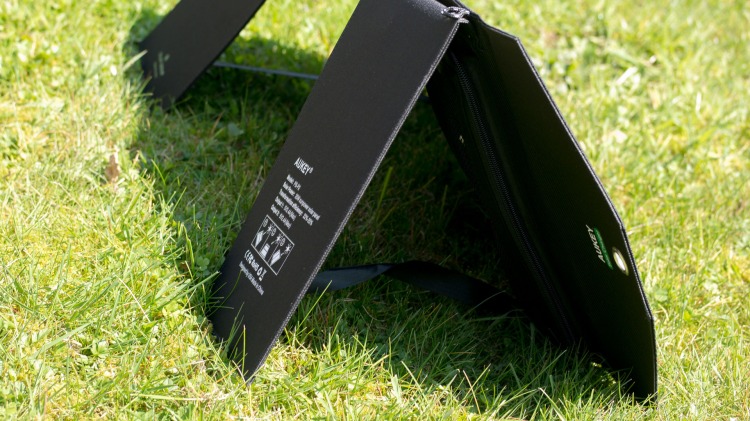
It makes the AUKEY solar charger very useful in practice! Correct alignment towards the sun may well bring 20-30% more energy.
Basically, all solar chargers here in the test are quite robust. A fall from a normal height is too dangerous for any panel.
The PVC fabric here protects the Chargers definitely quite good and serves in a fall as a “buffer”. The panels themselves are flexible to a certain extent.
When it comes to you robustness, so there are no huge differences between the various models.
General Questions and Answers
Before coming to the measurements a few typical questions and answers.
I want to attach the solar panel charger on my backpack to charge my phone while hiking. Is that possible?
Basically, yes it is possible. All tested solar panel chargers bring matching loops or holes for fastening. Ironically, however, only not with a too high energy yield! In the shadow of the solar panels produce almost no power (3-0W), therefore you’d better not just run with the back under the sun, the solar charger cannot collect so much sunshine.
Will My Solar Panels Work When It’s Cloudy or Rainy?
Solar photovoltaic (PV) panels generate the most energy per square meter when they receive direct sunlight.
But what happens when it’s overcast and rainy?
When clouds block out the sun, your solar panels will still produce clean electricity. This is true even in the wintertime (in fact, all things being equal, modern PV panels actually perform better in colder temperatures).
Can I use the Solar Panel Charger in the rain?
Basically, this is NOT recommended. Although the panels can all add water resistant function, but once it comes into the connection panel of the device, it can be dangerous.
Why all Solar Chargers look similar?
Probably all USB Solar Panels are from the same manufacturer just like AUKEY, Anker and EasyAcc.
Here, you can choose these panels according to your prefer. For example, you can select the charger with larger panels.
Can a solar charger damaging my phone / tablet?
Yes and no. In normal use, it cannot actually damage your devices. The tablet can be charge at the voltage up to about 5.2V.
However, in a sudden drop shadow, for example, by a passing person, come to a massive drop in the voltage.
This is not fatal for smartphones or tablets but also certainly not optimal.
I recommend that you can also use a buffer Power Bank. More info can be found later in the text.
What do you think of the various Solar Power Banks on the market, are not much more practical?
The idea of a power bank with built-in solar panel is of course great and practical, but it offer a very small area to collect energy and it usually outputs between 0.2W and 1W.
Compared with 5-18W of tested Solar Chargers, the solar power bank can output of course very little energy.
Test Setup
I run with all tested solar chargers by several load tests. The construction is always the same, the panel is extended, in most tests flat on the ground (in some but also aligned), and both USB ports each a meter + a blank power bank is connected.
Here I measure now how many watts the charger manages to generate.
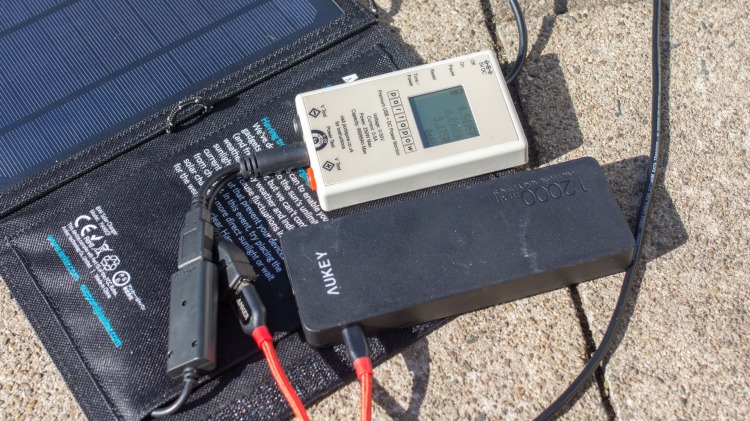
IMPORTANT! All tests were in April in Germany! Although I have chosen a very sunny day for this test, but you can certainly expect that you can use it in midsummer or in other regions of the world with even 20-30% better results.
It is of course same for all panels. So if a tested panel is better than others at the time under this testing weather conditions, this one will be also better than other solar panel chargers with other weather conditions.
See the test results values is not the best as their theoretical value! In my view, the realistic value which can be reached in Germany is certainly not the absolute maximum. See the values rather as a guide to what can be achieved, the individual USB Solar Charger.
Observations
We start with the measurements in the blazing sun.
|
Brand |
model |
1 |
2 |
3 |
4 |
5 |
6 |
Average |
|
AUKEY |
21W |
9,21W |
13,41W |
10,36W |
7,27W |
13,32W |
13,05W |
11,10W |
|
AUKEY |
20W |
9,47W |
10,35W |
10W |
7,36W |
10,02W |
13,12W |
10,05W |
|
AUKEY |
14W |
6,02W |
6,85W |
5,27W |
4,91W |
7,85W |
9,05W |
6,66W |
|
Anker |
21W |
9,05W |
12,81W |
9,91W |
7,67W |
12,59W |
12,95W |
10,83W |
|
Anker |
14W |
6,34W |
8,44W |
6,62W |
5,63W |
8,13W |
9,45W |
7,44W |
|
Anker |
8W |
4,1W |
5,84W |
4,78W |
3,18W |
5,23W |
6,19W |
4,89W |
|
EasyAcc |
15W |
5,87W |
8,5W |
6,65W |
4,93W |
8,76W |
8,7W |
7,24W |
|
EasyAcc |
28W |
12,26W |
16,88W |
13,29W |
10,31W |
18,88W |
16,84W |
14,74W |
|
IEC |
18W |
8,84W |
12,12W |
9,8W |
7,32W |
10,11W |
12,78W |
10,16W |
(Bigger = better)
The first thing you notice is that none of solar chargers even begin delivering the advertised by the manufacturer performance. Here it is natural to the extent possible, that the solar chargers come in other regions closer to the manufacturer’s instructions.
On average, the panel reached almost to the 50% of the manufacturer’s specification.
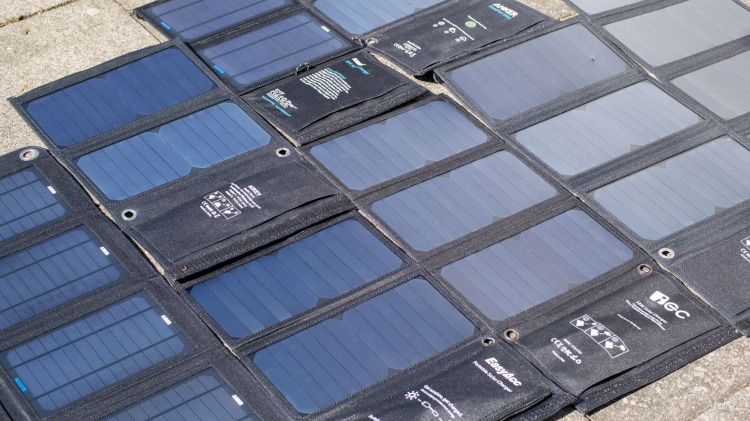
The best value in this case reached somewhat surprisingly the 8W panel of Anker with 61% on average. The worst value was 48% which the 14W AUKEY Panel and the 15W EasyAcc reached.
For more details you just look at the table.
However, these values are valid only in the blazing sun. How does the whole in the shade or partial shade?
|
Brand |
Model |
1 |
2 complete shadow |
3 |
Total Area |
|
AUKEY |
21W |
2,44W |
3,5W |
0,142W |
6,082W |
|
AUKEY |
20W |
1,34W |
3,28W |
0,174W |
4,794W |
|
AUKEY |
14W |
0,806W |
2,41W |
0,143W |
3,359W |
|
Anker |
21W |
1,28W |
3,38W |
0,18W |
4,84W |
|
Anker |
14W |
0,53W |
1,89W |
0,095W |
2,515W |
|
Anker |
8W |
0,64W |
1,56W |
0,103W |
2,303W |
|
EasyAcc |
15W |
0,78W |
2,35W |
0,102W |
3,232W |
|
EasyAcc |
28W |
2,48W |
4,16W |
0,865W |
7,505W |
|
IEC |
18W |
1,04W |
3,48W |
0,103W |
4,623W |
Here you can see a huge loss of power equally in all solar chargers.
In the complete shadow (value 2), the energy yield even goes back to just over 0th
What you learn from this? Only under the sun, the solar chargers are really efficient. With cloud days you can still expect about 20% of output in the shade with still significantly less.
A small note to 15W EasyAcc and 18W EC Technology Solar charger.
For my tests, I use the Aukey AIPowerTM PB-N28 12000mAh Power Bank, this produced at these chargers connected a “whistling”.
It strangely enough that only the 15W EasyAcc and 18W EC Technology emerged solar charger.
Based on the voltage values, I could not make out why it happened. It could be a slight visibility of such Power Bank in combination with these chargers, but I want to have mentioned this!
The AUKEY 20W PB-P2 had managed to bring my Gigaset ME Pro to reboot, when there was a sudden drop shadow. I would this not to hold against the Panel that this was a one-off “incident”.
The other solar chargers have shown no negative anomalies.
The size
A not to be underestimated factor is of course the size of the USB Solar Charger. Larger panels generally produce more energy and to ensure a lower surface, the manufacturer must rely on more efficient solar panels.
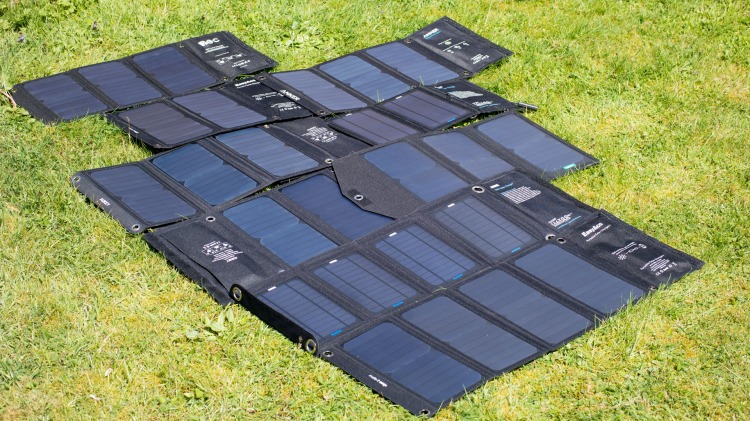
Interestingly, advertises example EasyAcc with an efficiency of “21.5 ~ 23.5%”, also AUKEY mention their conversion rate “up to 23.5%” too, this is a lot for a solar panel charger. After my research, in general, I can say that solar panel charger conversion rate can achieve up to 22% efficiency.
|
Brand |
Model |
Size |
Folded size |
surface area |
Surface area without control module Ben |
Surface area per 1W power |
|
AUKEY |
21W |
4x29x17cm |
70x29cm |
2030cm² |
1450cm² |
182,83cm² |
|
AUKEY |
20W |
4×30,5x17cm |
51×31,5cm |
1555cm² |
1555cm² |
154,68cm²* |
|
AUKEY |
14W |
3x29x17cm |
53x29cm |
1537cm² |
928cm² |
230,84cm² |
|
Anker |
21W |
3x28x15,5cm |
66x28cm |
1848cm² |
1288cm² |
170,64cm² |
|
Anker |
14W |
4x27x16,5cm |
87x27cm |
2349cm² |
1782cm² |
315,94cm² |
|
Anker |
8W |
2x23x16,5cm |
49x23cm |
1127cm² |
736cm² |
230,63cm² |
|
EasyAcc |
15W |
2x28x15,5cm |
49x28cm |
1372cm² |
840cm² |
189,63cm² |
|
EasyAcc |
28W |
3×28,5x17cm |
84×28,5cm |
2394cm² |
1767cm² |
162,38cm² |
|
IEC |
18W |
2,5x26x15,5cm |
66x26cm |
1716cm² |
1196cm² |
168,87cm² |
(Lower = better * the AUKEY 20W panel has its terminal unit at the back which is why the values appear as good)
In this table I have set the average power at the sun in relation to the surface.
Indicated how many will cm² required to produce 1W. There are two columns once with the completely folded-out area (including the case with the connector unit) and to the surface of the solar elements (including the small edge of the fabric but without the bag).
Unsurprisingly, the most efficient panels are the two EasyAcc Solar Panel Chargers and IEC and Anker 21W solar chargers.
Why unsurprisingly? The EasyAcc Solar chargers are the latest models in comparison, accordingly these seem to also have the latest technology. The same applies to the iEC 18W and 21W Anker.
The 14W Anker solar charger seems here to be the oldest model and accordingly provides the worst performance, size results.
Buffer Power Bank
Normally, I always recommend a buffer Power Bank, even if I myself do not always do this.
A buffer power bank should be a shield between the solar charger and your smart phone.
In the blazing sun even solar chargers have a fairly constant voltage. For example, a bird flying by or you can go even past the solar charger the voltage for a few seconds and then decreases sharply very fast again.
To protect against your Smartphone, I recommend the interposition of a power bank.
My current recommendation is the Aukey AIPowerTM PB-N28 12000mAh Power Bank. Why this? Firstly, it provides Power Bank with up to 3A! An extremely high loading speed which even in strong sunlight all produced energy can be absorbed.
Secondly, this power bank can be charged and charge at the same time. So you don’t need to wait too long until the Power Bank is fully charged, you can just directly connect your smartphone.
Test result, 9 USB Solar Charger compared
Which is the best solar charger for you will naturally depend on your needs. Will you prefer a heavier charger, a compact or a more favorable. A look of this most the tables from above and decide for yourself.
My recommendation ranking for a powerful solar charger.
- EasyAcc 28W portable solar charger
- AUKEY 21W PB-P4 solar charger
- Anker 21W Power Port 2-Port USB Solar Charger
The EasyAcc 28W charger is of course by far the most powerful charger in comparison with 65.99$, but also the most expensive one(Using the code 12OFFUS1 to get 12$ off, so that you can buy it at 53.99$).
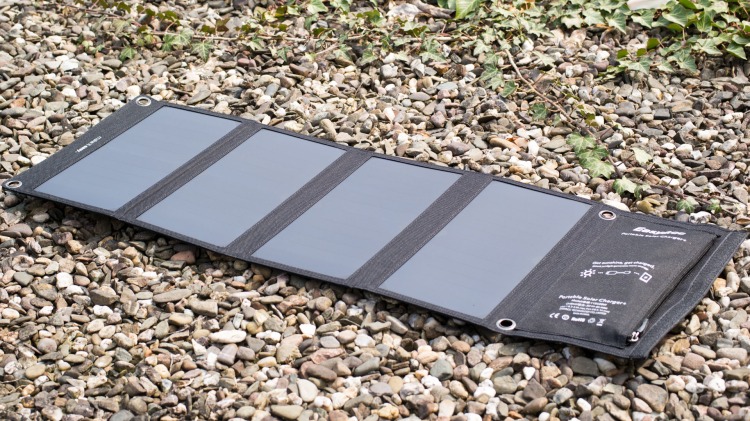
Here you do not have much more say, do you want the most performance then that’s your choice!
Alternatively, the AUKEY and Anker 21W charger has left a good impression. Both offer practically about the same performance, the AUKEY is still a lot bigger for but also cheaper and offers practical positioning aid, which is why I would prefer this.
But if it should arrive on size and weight, the Anker would be preferable.
When it comes to the price / performance, the world looks a little different, of course.
- EC Technology 18W 2 Ports Solar Charger
- AUKEY 21W PB-P4 solar charger
- EasyAcc 28W portable solar panel charger (Using the code 12OFFUS1to get 12$ off, so that you can buy it at 53.99$).
Somewhat surprisingly, sets the EC Technology Solar Charger to the top when it comes to the price / performance, followed by AUKEY 21W PB-P4 and the EasyAcc 28W charger (if you use the coupon).
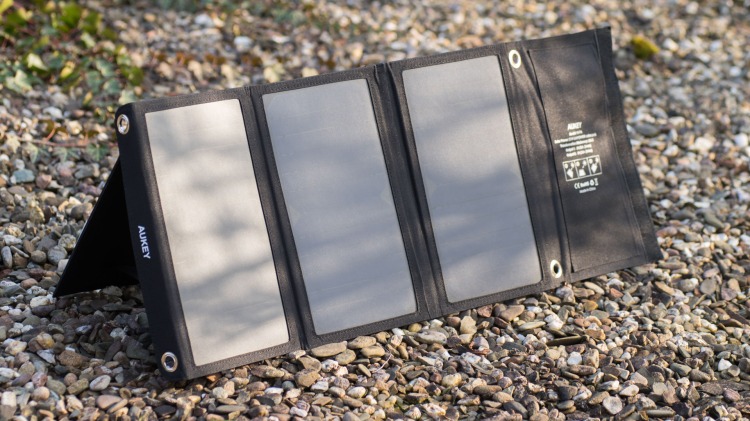
If I have to choose personally, I’d probably the AUKEY 21W PB-P4 or EasyAcc 28W choose portable solar charger, which I personally latter for the regular price of 53.99$, almost anything would be too expensive. (Using the code 12OFFUS1 to get 12$ off, so that you can buy it at 53.99$).

If you want more info about Anker Solar Charger or Ravpower Solar Charger, please check here for more about Ravpower vs Anker.
More Info about solar panel charger.

Making the best use of the best source of energy on the planet
赞赞
I need this in my life
赞赞
Impressive!
赞赞
I just got a new smartphone and am trying to learn as much as I can. No interest in camping.
赞赞
I want one that’s powerful and easy to carry.
赞赞
I want power and portability.
赞赞
Portability is essential, tyvm for the extensive information with detailed comparisons.
赞赞
Something easy to carry.
赞赞
I prefer the Aukey for it’s positioning system.
赞赞
Amazing solar power and portability. This would make my life so much better.
赞赞
Great!
赞赞
I love solar anything to save electric, these panels are very nice and I would love to win
赞赞
great ideas
赞赞
My Mum would love one…and so would I!
赞赞
Great!
赞赞
Does the Aukey battery support auto-on? If the battery drains out completely at night, in the morning will the battery turn on on its own after it gets some charge, without a human needing to press a button, or disconnect/reconnect device
赞赞